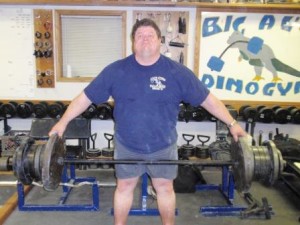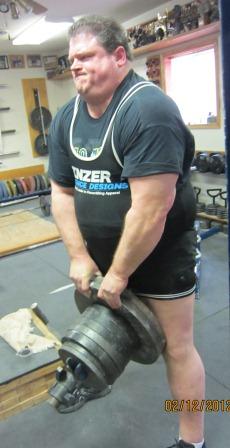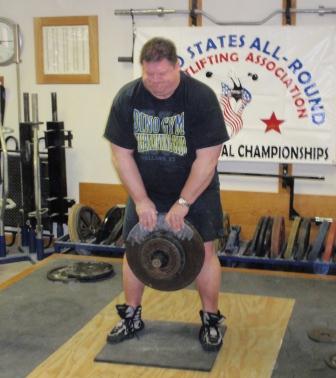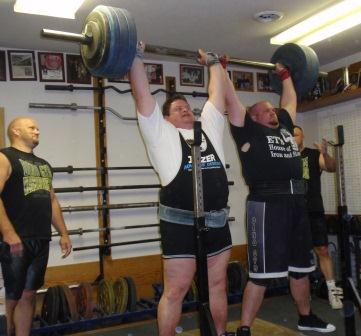by Al Myers
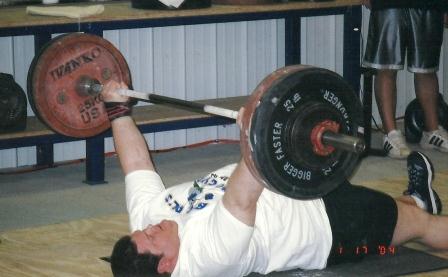
Mark Mitchell performing a Pullover and Push at the 2004 Dino Gym Challenge. Mark doing a pullover onto his 60 inch plus chest is the All-Round Weightlifting version of climbing Mt. Everest!
Recently I was asked about if there were any “secrets” to performing the pullover in the Pullover and Press. This lift (the Pullover and Press) will be a big part of this next years competitions, since it will be contested in both Nationals and Worlds. And don’t forget the Pullover and Push either, as it will be contested in the World Postal Meet coming up. So you can see the importance of understanding how to do a pullover, since it IS the first part of BOTH of these lifts. First let me say this about the pullover – IT IS NOT A PULLOVER! Too many lifters think it is, and try to lift the bar with their arms and shoulders onto their chest. They soon find out that this motion severely hinders their ability to get much weight to their chest, plus puts terrible unnatural stresses on the shoulder joints. You have to remember the OBJECT of the Pullover and Press is to lift as much as possible, and since it is a two part lift, one of the parts WILL be the limiting movement. Your goal should be to have the press or push be your limit, not what you can do in the pullover. However, I have seen the pullover be the limiting factor to many lifters in competition.
Now on to some advice from the Dino Man. I am going to make a disclaimer first: “If you weigh under 200 pounds- NONE of this advice applies to you!”. Light lifters with puny chests have no problem getting the bar in position on the chest for a press or push. They just roll it into place without encountering any difficulties. It’s the BIG GUYS I’m trying to help here. Guys over 250# BWT who have spent entirely too much training time on the bench press and have pecs that “mound up” like implants on the chest of a Vegas showgirl (haha, I can’t believe I SAID THAT because I don’t attend those sort of deviant activities But just LOOK at the chest of a bench press specialist, someone like Dave Beversdorf of Clarks Gym. Its freaky, but spectacular at the same time. Not that I’m saying Dave looks like a Vegas showgirl….Ok, I’m getting off course here. ). For these guys the pullover can be quite an embarrassment the first time they try it. As the bar approaches the chest as its rolled forward it “runs into a brick wall” as it encounters the pecs. I had one lifter ask me how its possible to get it onto his chest – because his chest is 6 inches higher than the bar! Well, that’s what I’m going to try to answer here.
Tip #1 Think FAST ROLL – not pullover
The main secret to getting the bar to the chest is a fast roll. More speed equals more momentum. And let me remind you of another thing – it’s going to hurt a little before it makes the climb to the chest. I like to have the bar at arms’ length on the platform and make a couple of slow “warmup” rolls to the top of the head before my final ALL OUT pull. This builds my confidence and prepares me mentally for the inevitable SLAM. I try to pull the bar as fast as I can with no regard to how much it might hurt when it impacts the chest. I think of it as just “taking a punch” before the lift starts. Also, be sure you turn your head slightly before it crosses over the head or the bar might impact the nose which could cause a broken nose.
Tip #2 Lift head at impact
This helps tremendously in getting the bar on the chest. Just as the bar is about ready to impact the chest, raise your head. This action causes the chest to drop slightly and the throwing of the head up helps with bar momentum at the last second.
Tip #3 Minimize resistance
Do everything possible to decrease resistance. This includes wearing a slick-fronted tshirt. DO NOT wear a tshirt with a sticky vinyl logo on the front as the bar will “stick” to this. I like wearing a tight fitting white tshirt. This is one lift where I don’t like to wear my singlet, as the straps will “catch” on the bar and add sliding resistance. Also, use a bar that does not have center knurling. I have found my deadlift bar to be the best bar to use for the pullover. Try to not use big thick rubber bumpers on the bar as this causes more friction resistance on the roll as well. Having the plates roll on wood is faster than on rubber mats. All of these things add up.
Tip #4 Use padding under the body
This is very important for a couple of reasons. The obvious first reason is to give some protection to the elbows when the forearms “turn over” as the bar goes onto the chest. It is critical that you use padding that is not to thick as this will raise the body up and make the pullover harder. I like using a towel or a thin rubber backed floor mat. However, the most important aspect of padding is to “stick” your body to the platform. I pull on the pullover so hard that my body will slide on a wooden platform without padding (towards the bar which slows things down).
Tip #5 Wide Grip
You can get a stronger pull with a wide grip than a narrow grip. When I do the pullover and push, I like a wide grip for my push so that is the grip I take for the pullover on that lift. However you can press more with a bench press grip, but you can still use a wide grip for the pullover part. Changing your hand spacing on the bar when it is on the chest is NOT a rule violation (as was clarified at this past years annual meeting when the rules changes where discussed). So if you NEED to do this for the pullover and press to help your pullover – do it.
These are my top five tips for the pullover. Incorporate these ideas and your pullover WILL NOT be the limiting factor in these two lifts (pullover and press and the pullover and push). Other little things help as well – wear wrist wraps to protect and support the wrists, wear elbow sleeves in training to protect the elbows from abrasions and hematomas (but elbow sleeves are not allowed in competition), and shaving your chest to minimize hair resistance (haha, maybe this is a stretch for most, but for guys like Scott Campbell it would take an inch off his chest height).
Make sure you practice the pullover for several training sessions before a competiton with the Pullover and Press/Push. Don’t be discouraged the first time you do it (or the first time back after a layoff of these lifts). Each subsequent training session you will find improvement if you follow these training tips.
